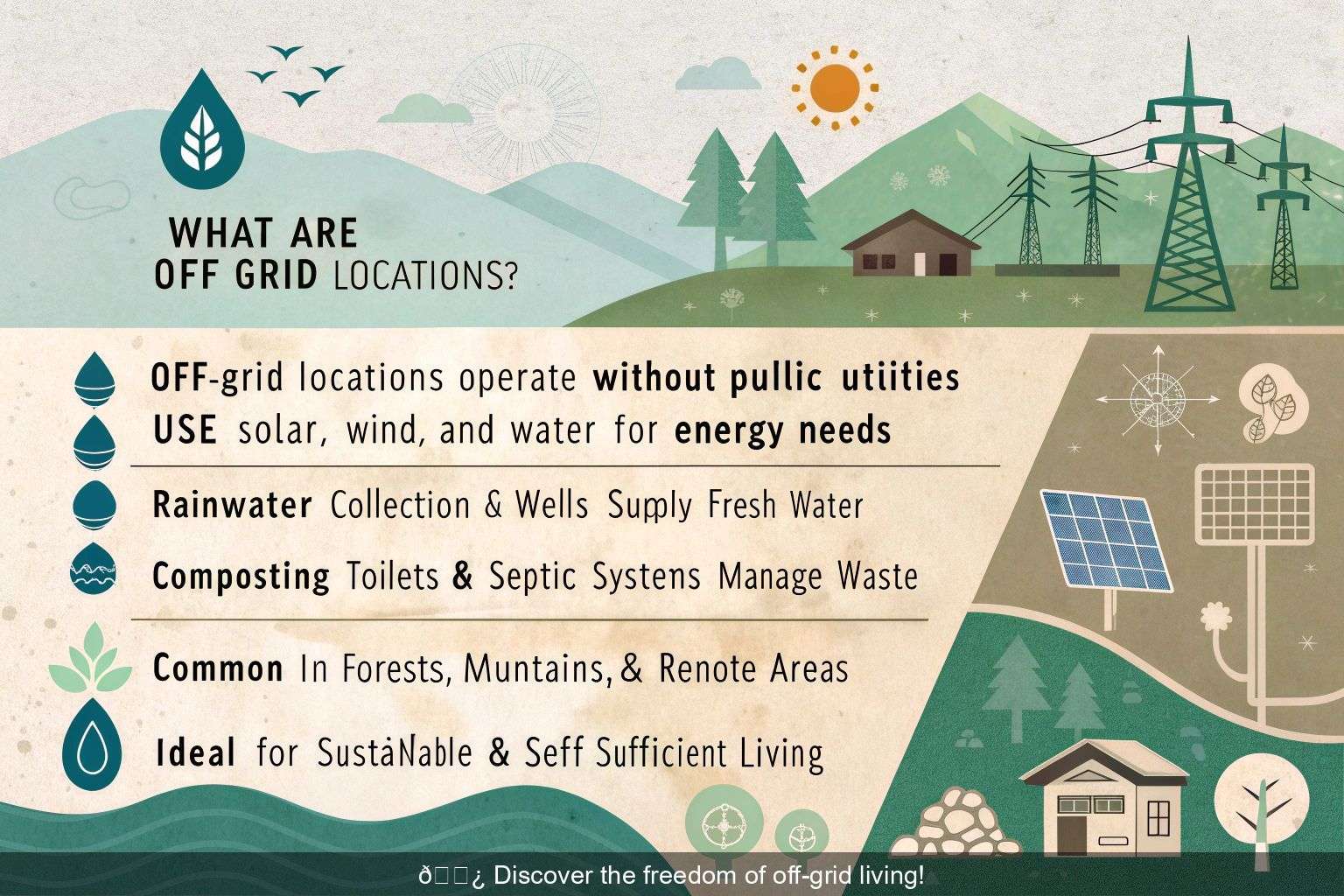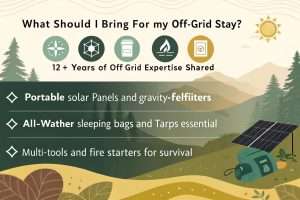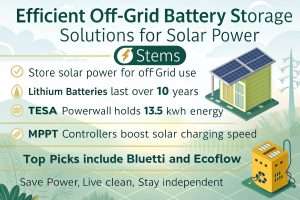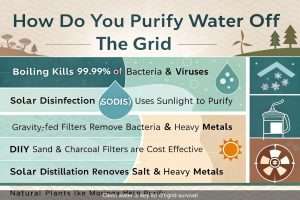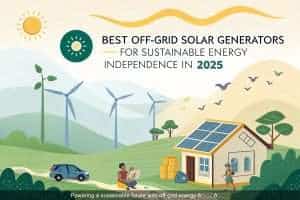Table of Contents
ToggleWhat Are Off Grid Locations? 🌍
Off-grid locations stand as self-sufficient spaces that operate without connections to public utilities. These places run independently from municipal power grids, water systems, and waste management services.
Based on Acorn Land Labs‘ study of 3,143 U.S. counties, successful off-grid spots need reliable water sources, favorable terrain, and suitable climate conditions.
Matt and Amy from OffGridDestinations.com showcase the real potential of off-grid living through their Costa Rica home project. Their experience proves that off-grid locations cost between $500 to $2,000 monthly to maintain, depending on renewable energy setups and land investments.
The lifestyle attracts people seeking freedom from utility bills while embracing sustainable practices like solar power, rainwater harvesting, and natural building methods while looking for the best places to live off-grid.
Introduction
More people now search for off-grid locations than ever before. These special places exist far from regular power lines, water systems, and city services. Living off-grid means creating your own power, collecting water, and handling waste without help from cities or towns.
Places like forests, mountains, and remote islands make perfect spots for this lifestyle. Matt and Amy from OffGridDestinations.com left their city life to build a self-sufficient home in Costa Rica.
Their story shows how those that want to live off-grid can switch to sustainable living.
Off-grid locations represent freedom from dependency and a return to natural living, shares Matt from OffGridDestinations.com.
The rising costs of utilities push many Americans to explore this way of life. Solar panels, water tanks, and modern technology make off-grid living easier than before. Remote workers choose these spots to escape busy cities and live closer to nature.
From Alaska’s wilderness to desert homes in Arizona, off-grid spots offer unique ways to live freely. Ready to discover what makes these places special?
Key Takeaways
- Off-grid locations operate without public utilities, costing $500-$2,000 monthly to maintain, with initial setup requiring solar panels, water systems, and waste management solutions.
- According to Acorn Land Labs’ study of 3,143 U.S. counties, successful off-grid spots need reliable water sources, good terrain, and suitable climate conditions for sustainable living.
- Real-world examples include Gaviotas in Colombia (200 residents), Kalu Yala in Panama (100 residents), and Matt and Amy’s Costa Rica homestead, all proving that off-grid communities can thrive through renewable energy and self-sufficient practices.
- The U.S. government’s goal of 100% clean electricity by 2035 supports off-grid living, with popular regions including the Pacific Northwest, Alabama, and Texas leading this movement due to favorable climate and flexible zoning laws.
- Off-grid locations face challenges in medical access and legal constraints, but solutions like satellite internet (up to 100Mbps), rainwater harvesting (600 gallons per 1,000 square feet), and solar power systems make modern off-grid living increasingly viable.
Growing Interest in Sustainable and Off-Grid Living
More people now seek freedom from traditional utility systems. A recent analysis by Acorn Land Labs shows growing interest across 3,143 U.S. counties for off-grid living options. The shift stems from rising utility costs and a strong desire for sustainable living practices.
People value self-sufficient lifestyles that reduce their environmental impact while maintaining modern comforts.
Matt and Amy’s platform reports a surge in off-grid property searches since 2020. Monthly expenses for off-grid setups range from $500 to $2000, making it an attractive option for cost-conscious individuals.
Popular regions like the Pacific Northwest, Alabama, and Texas lead this movement due to their favorable climate conditions and natural resources. The combination of water availability, suitable geography, and flexible zoning laws makes these areas ideal for sustainable living projects.
The Global Shift Toward Self-Sufficiency
A significant movement toward self-sufficient living has gained momentum across the globe. People now embrace off-grid solutions as a practical response to rising utility costs and environmental concerns. 4 The U.S. government’s commitment to achieving 100% clean electricity by 2035 has sparked increased interest in sustainable living practices.
Off-grid communities flourish in diverse locations from the Pacific Northwest to Costa Rica and New Zealand. Monthly expenses for this lifestyle range from $500 to $2000, making it an attractive option for those seeking financial independence.
Local building codes and zoning regulations shape the development of these self-sustaining spaces, while tools like Acorn Land Labs guide people through potential off-grid locations in U.S. counties.
Definition of Off-Grid Locations
Off-grid locations exist independently from public utility systems and municipal services. These self-sufficient spaces operate without connections to electrical grids, water mains, or sewage systems, relying instead on solar panels, wind turbines, well water, and septic systems.
Matt and Amy’s sustainable retreat in Costa Rica showcases how off-grid properties blend modern technology with natural resources to create fully functional living spaces away from traditional infrastructure. 5
What “Off-Grid” Really Means
Living independently from public utilities forms the foundation of true off-grid locations. People create sustainable spaces away from traditional power grids, water systems, and waste management networks.
Matt and Amy’s Costa Rica retreat showcases this independence through solar panels, rainwater collection, and natural waste processing systems.
True off-grid living means taking full responsibility for your essential needs while respecting nature’s rhythms, shares Matt from his self-sufficient homestead.
The monthly costs of maintaining an off-grid lifestyle range from $500 to $2000, depending on initial setup and ongoing maintenance. Solar power systems provide electricity, while water comes from wells or rainfall collection.
Waste management often involves composting toilets and natural filtration methods. States like Alabama and Texas lead the way in supporting legal off-grid setups through flexible building codes and zoning laws.
These locations demand careful planning, proper permits, and strong community connections for success.
Key Characteristics of Off-Grid Places
Off-grid places share distinct features that set them apart from typical residential areas. These locations exist far from public power lines, water systems, and sewage networks, requiring inhabitants to create their own sustainable infrastructure.
Solar panels, wind turbines, or hydroelectric systems generate power, while rainwater collection tanks and natural springs supply fresh water needs.
Remote wilderness areas offer the perfect setting for true off-grid living, as Matt and Amy discovered during their Costa Rica venture. The ideal off-grid spot combines rich natural resources with enough land for food production, energy generation, and waste management systems.
Natural features like streams, valleys, and abundant sunlight support self-sufficient living through permaculture practices and renewable energy solutions.
Types of Off-Grid Locations
Remote wilderness areas offer prime spots for off-grid living, including forests, mountains, and deserts across states like Alabama, Missouri, and Tennessee. Eco-communities and intentional villages provide structured environments with shared resources, such as Breitenbush Hot Springs Retreat in Oregon, where residents maintain sustainable practices through solar power and natural water sources. Mobile living options, such as vans, boats, and RVs, give adventurers flexibility to explore different climates while maintaining independence through portable solar panels and water collection systems.
Remote Wilderness Areas (Forests, Mountains, Deserts)
Forests, mountains, and deserts offer prime locations for off-grid living enthusiasts seeking true independence from conventional utilities. These wilderness areas provide natural resources like water sources, timber, and solar exposure essential for sustainable living practices.
Many off-grid pioneers choose mountainous regions for their abundant rainfall and natural springs, though steep terrain creates unique challenges for power system installation and resource transportation.
The U.S. states of Idaho, Colorado, and Northern California stand out as popular destinations due to their vast wilderness spaces and favorable regulations for off-grid setups.
The success of off-grid living in these areas depends heavily on proper water management and power generation systems. Forests supply valuable building materials and firewood while offering natural protection from harsh weather elements.
Desert locations excel in solar power potential but require careful water conservation strategies and storage solutions. Each environment demands specific survival skills – forest dwellers must master woodcraft, mountain residents need expertise in gravity-fed water systems, and desert inhabitants focus on shade structures and thermal management.
Local building codes and zoning laws still apply in these areas, making legal compliance a crucial step in establishing an off-grid homestead.
Off-Grid Communities and Ecovillages
Beyond remote wilderness areas, people create intentional off-grid communities to share resources and values. These ecovillages blend modern sustainable tech with traditional community living.
Groups of families build homes close together, sharing solar arrays, water systems, and organic gardens.
Off-grid communities like Breitenbush Hot Springs in Washington state showcase successful sustainable living models. The residents generate their own hydroelectric power, grow food year-round, and maintain a self-sufficient lifestyle.
Many US states now host thriving ecovillages that focus on low environmental impact through shared tools, skills, and support systems. These communities help new off-grid enthusiasts learn essential self-sufficiency skills while building meaningful connections.
Mobile Off-Grid Living (Vans, Boats, RVs)
Mobile off-grid living offers freedom through vans, boats, and RVs equipped with solar panels and wind turbines. These nomadic homes require careful planning for water storage, waste management, and power needs.
Many travelers choose this lifestyle to explore while maintaining a low environmental impact. Local laws guide parking spots and anchoring locations for these mobile dwellings.
Smart power management systems help mobile off-grid residents stay connected while reducing their carbon footprint. Solar panels generate electricity for basic needs like lighting, refrigeration, and device charging.
Water tanks and filtration systems ensure a steady supply of clean water. Composting toilets and gray water systems handle waste disposal needs. The next section explores how environmental sustainability drives the off-grid movement.
Why People Choose to Live Off the Grid
People embrace off-grid living to achieve true self-sustainability and financial independence. Many individuals seek freedom from rising utility costs and municipal services through renewable energy systems like solar power and hydroelectricity.
The desire for a sustainable lifestyle drives eco-conscious adventurers to explore alternative living arrangements in remote wilderness areas or intentional communities.
Environmental concerns push more Americans toward off-grid solutions each year. The ability to generate clean power, collect rainwater, and manage waste sustainably appeals to those worried about climate change.
Digital detox seekers value the peace found in locations away from crowded cities. Lower costs of living attract families looking to escape high urban expenses while building self-sufficient homesteads.
The growing interest in tiny house movements and sustainable design shows how off-grid destinations offer practical solutions for modern living challenges. Let’s explore the various types of off-grid locations available to aspiring off-gridders.
Environmental Sustainability
Off-grid living creates a direct path to environmental sustainability through renewable energy systems and smart waste management. Solar panels, backed by a 30% federal tax credit, offer homeowners a cost-effective way to reduce their carbon footprint while living sustainably off the land. The U.S. government’s push for 100% clean electricity by 2035 aligns perfectly with off-grid practices, making sustainable living more accessible and legally supported across different states.
Financial Independence & Cost of Living
Living off the grid offers significant financial advantages. Monthly expenses typically range from $500 to $2000, which includes basic necessities and system maintenance. The initial setup costs for renewable energy systems and water infrastructure require careful planning, yet the long-term savings prove substantial for many families seeking sustainable living options.
People achieve true financial freedom through reduced utility bills and self-sufficient practices. The upfront investment varies based on location and desired amenities, but most homesteaders report breaking even within 5-7 years.
Smart budgeting helps minimize ongoing costs while maintaining modern comforts. Solar panels, rainwater collection systems, and food gardens create multiple streams of resource independence that lower the cost of living substantially.
Privacy, Freedom & Minimalist Values
Off-grid locations offer people a chance to break free from constant digital surveillance and societal pressures. Many individuals choose this path to gain true independence through self-sufficient power systems, natural water sources, and sustainable food production.
The minimalist lifestyle promotes a deeper connection with nature while reducing material possessions, leading to greater personal freedom and mental clarity.
These secluded spaces create perfect environments for people to live according to their own values without external interference. Off-grid communities focus on essential needs rather than excessive consumption, allowing residents to maintain privacy through strategic land selection and thoughtful infrastructure design.
The peaceful solitude of remote areas enables inhabitants to practice mindful living away from the chaos of urban environments.
Real-World Examples of Off-Grid Locations
Real-world examples of sustainable living are evident in remarkable communities worldwide. Gaviotas in Colombia is a pioneering eco-village, where 200 residents use wind power and solar energy to meet their daily needs.
The community grows food in their greenhouses and maintains a thriving reforestation project across 20,000 acres of land.
Matt and Amy’s self-sufficient homestead in Costa Rica demonstrates modern off-grid possibilities. Their 10-acre property uses a 5kW solar system, gravity-fed water collection, and permaculture gardens to support their lifestyle.
Kalu Yala, Panama’s sustainable valley community, houses 100 residents who practice regenerative agriculture and zero-waste living. Their innovative building designs incorporate natural materials like bamboo and earthen construction methods to reduce environmental impact.
Gaviotas (Colombia)
Among notable off-grid locations worldwide, Gaviotas exemplifies sustainable living. This Colombian village demonstrates environmental consciousness and self-sufficient living practices.
Located in remote areas of Colombia, Gaviotas thrives through its strong community support system and commitment to sustainability. The village operates entirely off the main power grid, using natural resources and innovative solutions for daily needs.
Local residents maintain a relaxed lifestyle while fostering deep connections with nature. Their success shows that off-grid living can create both environmental harmony and social prosperity in secluded areas.
Kalu Yala (Panama)
Moving south from Colombia’s Gaviotas, Panama’s Kalu Yala stands as another remarkable example of sustainable off-grid living. This thriving eco-community sits in a diverse landscape that supports year-round food production.
The location’s natural water sources and solar power systems create a perfect setup for people seeking to live off the grid.
Kalu Yala promotes a laid-back lifestyle while maintaining modern sustainable practices. The community taps into natural resources through smart design choices and green technology.
Solar panels power homes and common areas, while fresh mountain springs supply clean water. Local gardens and farms produce food throughout the year, thanks to Panama’s tropical climate.
The mix of sustainable living and natural abundance makes Kalu Yala an ideal spot for off-grid enthusiasts and eco-conscious individuals to build their self-sufficient homes.
Matt & Amy’s Off-Grid Destination in Costa Rica
Matt and Amy built their off-grid paradise in Costa Rica over ten years ago. Their sustainable home runs entirely on solar power and draws water from natural sources, proving that off-grid living can blend comfort with eco-consciousness.
The property stands as a prime example of sustainable living, featuring year-round food production thanks to Costa Rica’s favorable climate.
The founders of OffGridDestinations.com transformed their Costa Rican property into a model of self-sufficient living. Solar panels power their daily needs while the surrounding natural beauty offers endless opportunities for sustainable food growing.
Their success story demonstrates how off-grid living combines environmental stewardship with practical self-reliance in an ideal location.
Challenges of Living in Off-Grid Locations
Living off-grid brings several key obstacles that require careful planning and preparation. Access to basic utilities poses the biggest challenge, with water and power systems needing regular maintenance and backup solutions.
Off-grid residents must secure reliable water sources through wells, rainwater collection, or natural springs while managing solar panels and batteries for electricity. The average monthly costs range from $500 to $2000 for essential resources and system upkeep.
Legal and practical hurdles create additional complexity for off-grid living. Building permits, zoning laws, and local regulations limit where people can establish off-grid homes. Medical emergencies demand extra consideration due to distance from hospitals and emergency services.
Smart planning helps reduce these risks through backup power systems, stored supplies, and strong connections with nearby communities. The setup requires substantial upfront investment in renewable energy infrastructure, though tax credits help offset initial expenses.
Access to Water, Power, and Internet
Off-grid locations demand careful planning for essential utilities and modern connectivity needs. Smart infrastructure choices make sustainable living possible while staying connected to the digital world.
- Solar panels produce reliable power in remote areas, requiring 6-8 hours of direct sunlight daily for optimal energy generation
- Rainwater harvesting systems collect about 600 gallons per 1,000 square feet of roof space during each inch of rainfall
- Deep-cycle batteries store excess solar energy, lasting 5-10 years with proper maintenance
- Satellite internet services reach speeds up to 100Mbps in remote areas through providers like Starlink
- Water filtration systems remove 99.9% of harmful contaminants from collected rainwater or well sources
- Backup generators running on propane or diesel fuel provide emergency power during cloudy periods
- Composting toilets reduce water usage by 90% compared to traditional flush systems
- Gray water recycling systems reuse household water for garden irrigation
- Cell phone boosters extend signal range up to 32 times in remote locations
- Energy monitoring systems track power consumption and help maintain system efficiency
- Water storage tanks hold 1,500-3,000 gallons for extended dry periods
- Solar water heaters cut energy costs by 50-80% for hot water needs
The next section explores medical services and emergency response challenges in remote settings.
Medical, Emergency, and Legal Constraints
Living off-grid brings unique challenges related to health and safety services. Medical care, emergency response, and legal requirements create significant hurdles for people seeking a self-sufficient lifestyle.
- Access to hospitals and clinics remains limited in remote areas, requiring careful planning for health emergencies and regular check-ups.
- Emergency response times stretch beyond 30 minutes in most off-grid locations, making basic first aid knowledge essential for residents.
- Local building codes demand specific permits for alternative energy systems like solar panels and wind turbines.
- Water catchment systems need regular testing to meet cleanliness standards set by state health departments.
- Many regions require proper septic system installation and maintenance documentation for waste management.
- Zoning laws restrict certain building materials and structure types in environmentally protected zones.
- Some states mandate grid connection for residential properties, making complete disconnection illegal.
- Insurance companies often charge higher premiums for properties without easy access to fire departments.
- Medical equipment that requires constant power needs backup systems and reliable energy storage solutions.
- Legal documentation proves challenging as many off-grid locations lack standard street addresses.
- Emergency communication systems must work without traditional cell service or internet connections.
- Local authorities require detailed site plans showing water sources and waste management systems.
- Healthcare providers might refuse home visits to extremely remote locations due to liability concerns.
- Some areas demand professional certification for installing alternative power and water systems.
Building Permits & Zoning Restrictions
Legal requirements shape the path to off-grid living across different regions. Local authorities maintain strict control over building permits and zoning laws to ensure safety and environmental protection.
- Building codes require specific permits for alternative energy systems like solar panels and wind turbines in most states
- Zoning laws restrict the types of structures allowed on rural properties, affecting tiny homes and earthships
- Health departments mandate proper septic system installation and water testing for off-grid properties
- Many counties enforce minimum square footage rules for permanent dwellings
- Property owners must obtain permits before installing rainwater collection systems in states with water rights laws
- Local authorities often limit RV parking duration on private land
- Building inspectors check off-grid power systems for safety compliance and proper installation
- Rural areas may restrict composting toilets or greywater systems
- Some regions ban complete disconnection from municipal utilities
- Environmental protection zones limit construction near sensitive habitats or water sources
- Fire safety codes require access roads and water storage for remote properties
- Agricultural zones might restrict residential building sizes and uses
- Setback requirements determine structure distance from property lines
- Deed restrictions in some areas prohibit alternative building materials
- Counties often require engineered plans for custom off-grid power systems
How to Find or Build an Off-Grid Location
Finding suitable off-grid land starts with careful research of water sources, building codes, and local zoning laws. Smart buyers check the terrain, soil quality, and natural resources before purchasing remote properties.
The land must offer reliable access to water through wells, springs, or rainfall collection systems. Solar exposure plays a vital role in generating power through photovoltaic panels.
Building an off-grid home requires proper planning and infrastructure setup for basic utilities. The construction process demands careful attention to energy systems, water storage, and waste management solutions.
Most successful off-grid builders start with a tiny house or cabin design to minimize resource needs. They install solar panels, batteries, water tanks, and composting toilets as core systems.
The setup costs range between $30,000 to $100,000 depending on location and amenities. Popular areas include forests in Washington state, mountains in North Carolina, and desert regions in Hawaii where sustainable living thrives.
Land Selection & Legal Considerations
Selecting land for off-grid living requires careful attention to local regulations and natural resources. Smart land selection forms the foundation of a successful off-grid lifestyle, blending legal compliance with practical needs.
- Local zoning laws make a huge impact on off-grid plans. Each county has different rules about building codes, minimum square footage, and utility hookups.
- Water rights stand as the most crucial factor in land selection. Property owners must verify access to groundwater, surface water, or rainwater collection permissions.
- Building permits play a vital role in legal off-grid construction. Many counties require approved plans for septic systems, solar arrays, and structural elements.
- Soil testing proves essential for determining septic system feasibility. The local water table depth affects both well placement and waste management options.
- Property taxes and assessment rates vary by location. Rural areas often offer lower tax rates but may have strict agricultural or residential zoning requirements.
- Road access and easements impact year-round living potential. Legal right-of-way agreements ensure continuous access to the property.
- Natural hazard zones affect insurance costs and building options. Areas prone to floods, fires, or extreme weather need extra planning and safety measures.
- Local climate determines solar power potential and growing seasons. Sun exposure, rainfall patterns, and temperature ranges shape sustainable living strategies.
- Population density influences privacy and resource availability. Less populated areas offer more freedom but may lack emergency services.
- Legal documentation needs include land surveys, deed restrictions, and mineral rights. Title searches reveal any hidden limitations on property use.
- Distance to medical facilities impacts safety planning. Many counties require homes to stay within a specific range of emergency services.
- Utility company territories affect grid-tie options. Some areas allow easier future connections to power or water systems if needed.
Energy, Water, and Waste Infrastructure Setup
Setting up infrastructure marks the core foundation of successful off-grid living. Modern off-grid locations need careful planning for energy generation, water access, and waste management systems.
- Solar panel systems produce reliable power through photovoltaic cells, requiring 6-12 panels for basic home needs and energy storage batteries
- Wind turbines serve as backup power sources in areas with steady wind speeds above 9 mph, generating 400-3000 watts per day
- Rainwater collection systems capture fresh water through roof gutters and storage tanks, filtering 2500 gallons annually for a typical household
- Natural springs and wells tap into groundwater sources, needing proper permits and quality testing before use
- Greywater systems reuse household water from sinks and showers for garden irrigation, saving up to 40% of water consumption
- Composting toilets break down waste naturally without water, producing useful soil after 6-12 months of decomposition
- Septic systems process blackwater through underground tanks and drain fields, requiring annual maintenance checks
- Battery banks store excess energy from solar panels, typically holding 48V systems for 3-4 days of backup power
- Micro-hydro power systems harness flowing water to generate electricity, producing 1-100 kilowatts in suitable locations
- Water filtration units remove contaminants through UV light and carbon filters, processing 50-100 gallons daily
- Food storage cellars maintain steady temperatures between 32-40°F for preserving supplies without electricity
- Waste recycling stations sort materials for composting, burning, or transport to processing facilities
- Thermal mass walls store solar heat during winter months, reducing energy needs by 20-30%
- Biogas digesters convert organic waste into cooking fuel, producing 2-4 hours of daily cooking gas
- Monitoring systems track resource usage and system performance through basic meters and gauges
Tools, Skills, and Community Support
Moving beyond infrastructure setup, successful off-grid living demands specific tools and abilities. People need both physical equipment and practical knowledge to thrive in self-sufficient locations.
- Solar panel installation tools cost around $2,500 for a basic setup, including inverters, charge controllers, and safety equipment
- Basic carpentry tools help create and maintain structures, such as circular saws, drills, and measuring instruments for building repairs
- Water testing kits and filtration systems ensure safe drinking water meets cleanliness standards
- Communication devices like satellite phones or ham radios maintain contact during emergencies
- Gardening equipment supports food production through tools like shovels, hoes, and seed starting supplies
- First aid kits and medical supplies provide essential care due to distance from hospitals
- Power generators serve as backup systems during periods of limited solar energy
- Online forums connect off-grid residents to share tips and support across different states
- Local off-grid communities offer hands-on training in sustainable living practices
- Skill-sharing workshops teach crucial abilities like food preservation and energy management
- Building permit guides help navigate legal requirements across various locations
- Resource libraries contain information about water sourcing and waste management
- Tool-sharing programs reduce individual costs for expensive equipment
- Emergency response networks link isolated residents during natural disasters
- Mentorship programs pair new off-grid residents with experienced individuals
Conclusion
Off-grid locations offer a path to true independence and sustainable living through self-sufficient systems for power, water, and food production. More people now embrace this lifestyle as a practical solution to rising living costs and environmental concerns.
The future of off-grid living looks bright as new technologies make sustainable systems more affordable and efficient, while growing communities share knowledge and resources through platforms like OffGridDestinations.com.
The Future of Off-Grid Living
The rise of sustainable technology points to a bright future for off-grid living. Solar panels now cost 70% less than they did in 2010, making renewable energy more accessible. Smart home systems and energy storage solutions continue to advance rapidly.
Technology improvements will transform self-sufficient homes in the next decade. Satellite internet services like Starlink already provide reliable connections to remote areas. New water filtration systems and waste management solutions make living off-grid easier than ever.
More people seek this lifestyle as cities become crowded and expensive. States across America now create friendlier laws for sustainable living practices.
Moving from future trends to practical steps, aspiring off-grid enthusiasts need reliable resources to start their journey. Several trusted platforms offer valuable guidance for off-grid living preparations.
Acorn Land Labs provides 55 detailed PDF guides that analyze off-grid potential across U.S. counties. OutboundLiving shares essential tips about water systems, solar setups, and land selection processes.
VanClan offers specific insights for mobile off-grid solutions.
OffGridDestinations.com stands out as a primary resource hub for sustainable living information. Their platform features cost breakdowns ranging from $500 to $2000 monthly expenses, location guides highlighting states like Alabama, Missouri, Georgia, and Texas, plus zoning regulation updates. TinyHouseTalk presents practical advice about water availability, terrain assessment, and temperature considerations. PureLivingForLife shares real success stories from established off-grid communities, helping newcomers learn from experienced practitioners.
FAQs: Common Questions About Off-Grid Locations
Off-grid locations spark many questions from people interested in sustainable living. Legal requirements vary across states, with Alabama and Texas offering more lenient regulations for off-grid setups.
Monthly costs range from $500 to $2000, depending on initial investments in solar panels, water systems, and other essential infrastructure.
People need permits and must follow local building codes for their off-grid homes. Basic requirements include proper water systems, waste management, and renewable energy sources like solar power.
The lifestyle demands careful planning around food storage, medical access, and emergency services while maintaining independence from municipal utilities.
Are off-grid locations legal everywhere?
Legal requirements shape the reality of off-grid living across different regions. Living off the grid stays legal in the United States, provided residents follow local building codes and zoning laws.
Each area maintains specific rules about water rights, energy systems, and building practices. Local authorities require permits for alternative power setups, water collection methods, and property construction.
Many regions demand compliance with strict regulations for wells and septic systems. Several states limit rainwater harvesting due to existing water rights laws. Building inspectors must approve any structural changes or additions to ensure safety standards.
The success of an off-grid project depends heavily on understanding these location-specific legal frameworks before starting construction.
Can I live off-grid without solar power?
Living off-grid without solar power offers several practical alternatives for sustainable energy. People can harness wind power through turbines, which generate electricity from strong air currents in open areas. Hydropower systems tap into flowing water sources to create energy for off-grid homes near streams or rivers. Many off-grid enthusiasts combine these power sources with wood stoves for heating and cooking needs.
Off-grid locations rely on multiple energy sources to maintain self-sufficiency throughout the year. A typical off-grid setup costs between $500 to $2000 monthly, depending on the chosen power system and location.
States like Alabama and Missouri support various off-grid energy options through flexible building codes. Micro-hydro systems work well in mountain regions, while wind turbines suit open plains.
Each power source needs careful planning to match the specific climate and terrain of the chosen off-grid spot.
What’s the difference between off-grid and remote living?
Off-grid living focuses on complete independence from public utilities through self-sustaining systems like solar panels, water collection, and waste management. Remote living simply means staying far from civilization while still possibly relying on standard utility connections.
The main distinction lies in resource management – off-grid locations require careful planning for food, water, and energy needs, while remote spots may maintain traditional utility hookups despite their distance from towns.
Many people mix up these terms, but self-sufficiency remains the key factor that separates true off-grid locations from merely remote ones, especially in states like Washington and Georgia where both lifestyles thrive.
Next, we’ll explore various types of off-grid locations across different terrains and settings.
How do I find land for off-grid living?
Acorn Land Labs offers guides that rate U.S. counties from A to F for off-grid living suitability. Prudent land scouts should examine water rights, building codes, and local zoning laws prior to purchasing.
The terrain, climate, and population density are key factors in selecting an ideal location for sustainable living.
Legal requirements differ across states, necessitating thorough research for success. Each county maintains specific regulations regarding water collection, solar installations, and waste management systems.
Optimal locations provide natural water sources, favorable weather patterns, and reasonable proximity to emergency services. Prospective off-grid residents should then consider the practical aspects of establishing essential infrastructure.
Is off-grid living more affordable in the long run?
Off-grid living offers significant cost savings over time despite higher upfront investments. Monthly expenses typically range from $500 to $2000, which proves lower than traditional urban living costs.
The initial setup requires substantial capital for land purchase, renewable energy systems, and sustainable infrastructure. Solar panels, water collection systems, and waste management solutions create long-term financial benefits through reduced utility bills.
Local regulations play a vital role in the total cost structure of off-grid living. Many states provide tax credits and financial incentives for sustainable energy adoption. Smart planning and proper budgeting help minimize ongoing maintenance expenses.
The replacement costs for renewable systems need careful consideration in the long-term financial plan. Most off-grid residents report breaking even on their initial investments within 5-7 years through reduced monthly expenses and sustainable resource management.
FAQs
1. What does living off the grid mean?
Living off the grid refers to a self-sufficient lifestyle where people live sustainably without relying on public utilities. This way of living often involves using photovoltaics for power and creating independent water supply systems.
2. Which are the best states for off-grid living in America?
Washington state and Georgia rank among the top states for off-grid living due to their favorable climate and regulations. These locations offer low cost of living and many off-grid communities.
3. Are there legal restrictions for off-grid living in the United States?
The legality of off-grid living varies by state, with some having strict regulations about water collection and energy development. Always check local laws before setting up an off-grid home.
4. What should I consider when choosing an off-grid location?
Consider factors like water scarcity, building restrictions, climate, and access to off-grid infrastructure. Your chosen location should support your goals for living self-sufficiently.
5. How much does it cost to live off the grid?
The average cost of living off-grid varies greatly depending on your location and lifestyle choices. Initial setup costs include land purchase, solar panels, and water systems, while ongoing expenses are typically lower than traditional living.
6. Are there existing off-grid communities I can join?
Yes, intentional communities like Breitenbush Hot Springs Retreat & Conference Center offer established off-grid living experiences. Many states have thriving off-grid communities where individuals share resources and knowledge.
Disclaimer: This content is for informational purposes only and should not be considered professional, legal, or financial advice. Please consult a licensed expert before making decisions related to land, zoning, or off-grid living.
Affiliate Disclosure: Some links in this article may be affiliate links. This means we may earn a small commission—at no extra cost to you—if you make a purchase through them. Your support helps keep OffGridDestinations.com running.
Background: Matt & Amy from OffGridDestinations.com have lived off the grid in Costa Rica for over a decade. They offer real-world insights into sustainable living, off-grid setups, and the best locations for those seeking a self-sufficient lifestyle.
References:
https://en.wikipedia.org/wiki/Off-the-grid
https://www.bluettipower.com/…/the-best-places-to-live-off-grid
https://www.bluettipower.com/…/the-best-places-to-live-off-grid
https://www.worldpackers.com/articles/off-the-grid-communities
https://www.bloomenergy.com/…/off-grid-power-systems
World Bank Group Renewable Energy Report (PDF)
https://rethinkrural.raydientrural.com/blog/6-features-you-need
https://www.mdpi.com/1996-1073/11/11/3141
https://flexens.com/unlocking-off-grid-hydrogen-production
https://en.wikipedia.org/wiki/List_of_wilderness_areas_of_the_United_States
https://www.jackery.com/blogs/lifestyle/off-gid-living-communities
Building an Off-Grid Solar System (Amazon)
https://onestepoffthegrid.com.au/200-reasons
https://sunnysimpleliving.com/reasons-why-people-live-off-grid/
https://www.mdpi.com/2071-1050/8/12/1326
https://www.mdpi.com/2071-1050/10/12/4512
https://valleyfoodstorage.com/…/find-the-best-place
https://www.aimspress.com/article/doi/10.3934/ctr.2022011
https://www.sciencedirect.com/science/article/abs/pii/S0360319923007590
https://colombiareports.com/las-gaviotas
https://en.wikipedia.org/wiki/Kalu_Yala
https://offgriddestinations.com/about/
https://sunnysimpleliving.com/meaning-of-off-grid-living/
https://www.federalregister.gov/…/heat-injury-and-illness-prevention
https://ppm.solar/can-you-go-off-the-grid-in-florida/
https://sunnysimpleliving.com/find-an-off-grid-property/
https://www.landleader.com/buying-off-grid-land
https://communitylands.com/…/buying-land-for-off-grid-living
Building a Low Impact Roundhouse (PDF)
All About H3: Your Questions Answered
https://www.esri.com/…/use-h3-hexagons-for-spatial-analysis
https://www.planradar.com/au/the-future-of-off-grid-homes/
https://www.jackery.com/blogs/lifestyle/off-gid-living-communities
https://firemountainsolar.com/learn/off-grid-solar/off-grid-solar-faq/
https://unboundsolar.com/blog/off-grid-legal-states
https://unboundsolar.com/blog/off-grid-legal-states
https://blog.ecoflow.com/us/differences-between-on-grid-off-grid-solar-system/
https://www.cnet.com/…/heres-the-savings-i-saw-and-hidden-expenses
https://realestate.usnews.com/articles/the-guide-to-off-grid-homes











